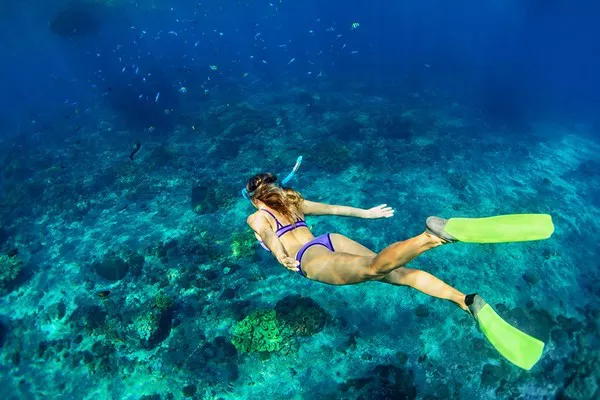Snorkeling, a popular recreational activity enjoyed by millions worldwide, offers a unique opportunity to explore the underwater world without the need for complicated equipment or extensive training. But for beginners and even some experienced snorkelers, the question often arises: just how deep is snorkeling water? Understanding the depth of water suitable for snorkeling is crucial for ensuring a safe and enjoyable experience. In this article, we’ll delve into the depths of snorkeling water, exploring factors that influence depth, safety considerations, and tips for maximizing your snorkeling adventure.
Understanding Snorkeling Depth
One of the defining features of snorkeling is that it typically takes place in relatively shallow waters. Unlike scuba diving, where divers can descend to great depths using specialized equipment, snorkelers remain close to the surface, allowing them to breathe naturally through a snorkel tube while observing marine life below.
While there’s no hard-and-fast rule for the maximum depth for snorkeling, it’s generally accepted that depths of around 10 to 15 feet (3 to 4.5 meters) are ideal for most snorkelers. This depth provides ample opportunity to observe underwater ecosystems while still allowing easy access to the surface for breathing.
However, the depth of snorkeling waters can vary significantly depending on several factors, including location, water conditions, and individual snorkeler abilities.
Factors Influencing Snorkeling Depth
1. Location: The depth of snorkeling waters can vary greatly depending on where you’re snorkeling. Coastal areas, lagoons, and coral reefs typically offer shallow waters ideal for snorkeling, with depths ranging from a few feet to around 15 feet. In contrast, open ocean environments may feature deeper waters, making them less suitable for snorkeling without proper supervision and equipment.
2. Water Conditions: Water conditions, such as currents, waves, and visibility, play a significant role in determining snorkeling depth. Calm, clear waters are ideal for snorkeling, as they provide better visibility and safety for exploring underwater environments. In contrast, rough seas and strong currents can make snorkeling more challenging and limit the depth at which it’s safe to explore.
3. Individual Abilities: Personal comfort and swimming proficiency also influence the depth at which an individual can snorkel safely. While some experienced snorkelers may feel comfortable exploring depths of up to 15 feet or more, beginners and less confident swimmers may prefer to stay in shallower waters where they can easily touch the seafloor and access the surface if needed.
4. Marine Life: The presence of marine life, particularly near the ocean floor, can also influence snorkeling depth. Snorkelers may be drawn to deeper waters to observe certain species or habitats, but it’s essential to balance curiosity with safety and ensure that the chosen depth is within one’s comfort and skill level.
Safety Considerations for Snorkeling Depth
While snorkeling is generally considered a safe activity, there are several important safety considerations to keep in mind when exploring varying depths:
1. Buddy System: Snorkeling with a buddy is always recommended, regardless of depth. Having a companion nearby provides an added layer of safety and assistance in case of emergencies.
2. Know Your Limits: Understand your own swimming abilities and comfort level in the water. It’s essential to stay within a depth range that you feel confident navigating without risking exhaustion or panic.
3. Monitor Conditions: Pay attention to water conditions such as currents, waves, and visibility. Avoid snorkeling in rough seas or strong currents, as these conditions can increase the risk of accidents or getting swept away from shore.
4. Equalize Ear Pressure: While snorkeling at shallow depths, ear pressure may not be a significant concern. However, if you plan to explore slightly deeper waters or dive down to observe marine life, it’s essential to learn how to equalize ear pressure to prevent discomfort or injury.
5. Respect Marine Life: Avoid touching or disturbing marine life, and be mindful of your surroundings to minimize the risk of accidental encounters with potentially harmful species.
6. Use Proper Equipment: Invest in high-quality snorkeling gear, including a well-fitting mask, snorkel, and fins. Ensure that your equipment is properly maintained and functioning correctly before entering the water.
Tips for Maximizing Your Snorkeling Adventure
1. Choose the Right Location: Research snorkeling destinations known for their shallow, clear waters and abundant marine life. Popular snorkeling spots include tropical reefs, marine reserves, and sheltered bays with calm conditions.
2. Practice Proper Technique: Take the time to practice basic snorkeling techniques, such as breathing through the snorkel tube, clearing water from the mask, and using fins to propel yourself through the water efficiently.Stay Relaxed: Relaxation is key to enjoying a successful snorkeling experience. Practice controlled breathing and avoid tensing up, as this can lead to fatigue and discomfort.
3. Observe Safety Guidelines: Always adhere to safety guidelines and regulations provided by local authorities or tour operators. These guidelines are in place to ensure your safety and protect the marine environment.
4. Respect Wildlife: Take only photographs and leave only bubbles. Avoid touching or disturbing marine life, and refrain from feeding fish or other animals, as this can disrupt their natural behavior and ecosystem balance.
Conclusion
In conclusion, the depth of snorkeling water can vary depending on location, water conditions, and individual abilities. While snorkeling is generally a safe and enjoyable activity, it’s essential to understand your limits, practice proper safety precautions, and respect the marine environment. By following these guidelines and tips, you can maximize your snorkeling adventure while ensuring a safe and memorable experience beneath the waves.

